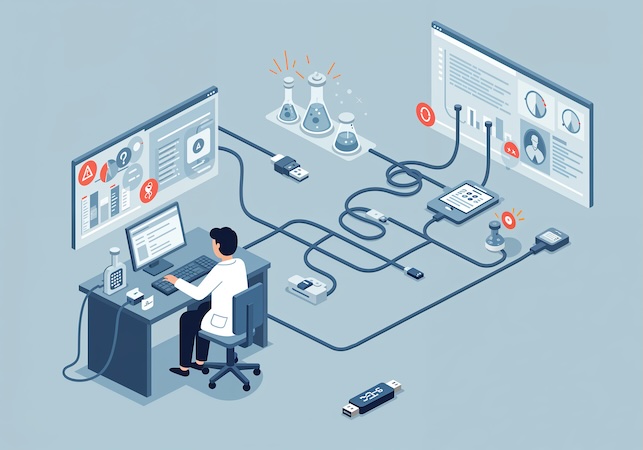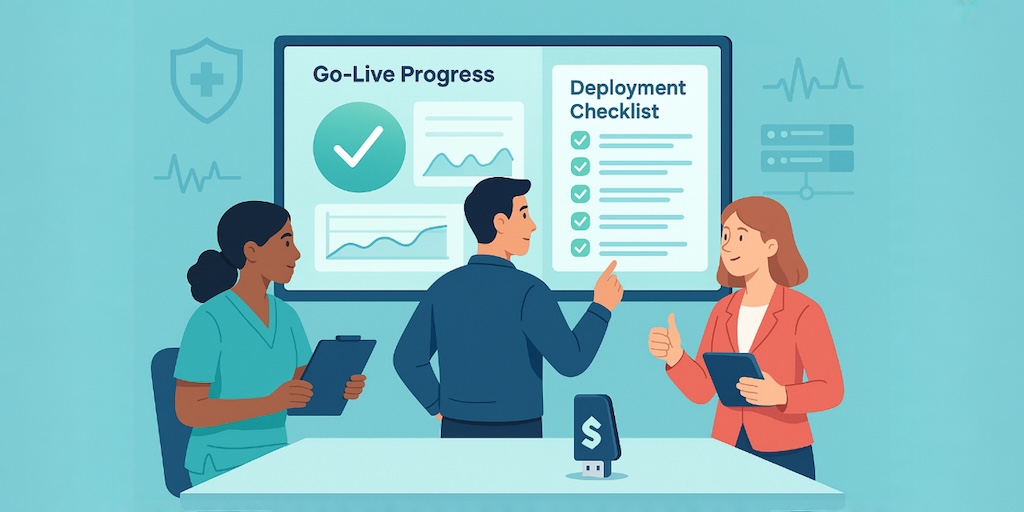How to Build a Medical Practice Management App in 2025: A No-B.S. Field Guide for Clinician-Founders
Monday, 7 a.m.—your front desk is triaging double-bookings, the fax machine is still the “integration layer,” and a payer portal just insisted your patient’s insurance doesn’t exist.
If that scene feels normal, you’re overdue for a practice-management platform that works harder than you do—and in the pages ahead we’ll map the route and point out the shortcut.
Key Takeaways
- Legacy PM software silently drains access, safety, speed, and cash; upgrading isn’t cosmetic—it’s existential. Stop paying the middleware + swivel-chair tax; reclaim clinician time and audit sanity.
- Composing with HIPAA-ready components lets clinician-founders launch in weeks, not years, while owning their IP. Add a healthcare AI builder to reshape workflows in plain English, plug into EHR/payments, and avoid platform lock-in.
- Budget cliffs (compliance, integrations, cloud steps) appear sooner than you think; model them early or refinance later. Price BAAs, data migration, observability, and uptime SLAs up front—or watch “later” become a rewrite.
Why the 2025 Practice Can’t Run on 2012 Software
Four silent killers—access, safety, speed, and cashflow—are baked into your legacy stack. Here’s the body-count.

Access Meltdown ↠ Fragmented Scheduling
No-shows climbed to 6.81% of all visits in 2023—up from 5% just two years prior—while 94% of patients now wait more than two weeks for an appointment.
That idle chair isn’t “just admin friction”: one mid-sized group bleeds $7 million a year on 67k missed slots (≈ $265 each).
Worse, 61% of consumers bail on care altogether when online booking feels like 1999.
Translation: your front door is stuck half-open.
Safety Gap ↠ Missed Diagnoses from Fragmented Records
Data silos now surface in 61% of ambulatory malpractice claims, and 92% of those errors happen in the testing phase—labs ordered, results orphaned, follow-up forgotten.
Patients can see the cracks: 14.9% spot mistakes in their own visit notes before anyone on the care team does.
Every lost lab result is a future deposition.
Slow Brain ↠ Clinical Decision Delays from System Silos
72% of providers fight interoperability gremlins daily, and fewer than one-third of U.S. hospitals can ingest outside patient data electronically.
Even the vendors confess: 42% of execs finger their own EHR supplier as the main roadblock.
While your team faxes PDFs, sepsis keeps the timer running.
Margin Erosion ↠ Revenue Bleeding from Administrative Chaos
Administrative busywork now soaks up $496 billion a year—25-30% of every healthcare dollar, double other industries.
Clinicians add 1.84 after-hours EHR hours per day, and practice overhead ballooned 29% in five years (≈ $801k).
That’s not “paperwork”; it’s profit vapor.
Bottom line: Stick with 2012 tooling and you’ll keep ghost-funding empty slots, malpractice payouts, fax-powered medicine, and an admin bonfire the size of a Series A. Time to upgrade—or keep donating margin to the healthcare abyss.
From Clinical Protocols to Digital Workflows
Your care algorithms already live in physicians’ heads and battered binders; let’s make them click-to-run.

Surface the Playbook
- Pull the recipe onto one page. Hunt down triage checklists, “Dr Lee’s Post-Op Rules,” and those Excel risk grids everyone swears by.
- Label decisions and data. For every step ask, “What inputs do we trust? What action must fire?”
- Anchor to one outcome metric (e.g., time-to-diagnosis) and one ops metric (mouse-clicks per visit).
Why bother? Physicians are now expecting tech help—AI tool adoption leapt from 38% to 66% between 2023-2024.
Stratify Patients and Trigger Actions
- Stratification engine. Auto-bucket patients by risk (think: GAD-7 tiers, CHF flags) so nurses stop combing spreadsheets.
- Decision trees. “If A1c ≥ 9% + neuropathy flag → podiatry consult.” Simple rules save brain cycles; complex ones can borrow AI as confidence grows.
- Smart nudges. Only the high-fracture cohort gets the DEXA reminder, not Monday’s entire schedule.
Workflow automation isn’t fluff—$16.3B a year sits on the table, with AI projected to trim 50-60% of rote admin clicks.
Close the Loop on Care Coordination
- Event-driven alerts. Abnormal lab? Text the patient and drop a task on the RN board within five minutes.
- Cross-team task boards. Let PTs, RNs, and billing see the same workflow card—no more side-channel emails.
- Auto-document everything. Each branch the algorithm takes writes a note and audit trail; compliance adores this.
Measure and Iterate (or It Didn’t Happen)
- Real-time dashboards tie protocol version 1.3 to patient outcomes.
- A/B your algorithms. Run two discharge instructions, keep the one that halves readmissions.
- Continuous improvement cadence: monthly review, tweak thresholds, redeploy—no developer-speak required.
Pitfalls to Dodge
Take-home: Map the brain work first, then let technology shoulder the repetition. Do it right and the tech pillars we’re discussing next drop into place like Lego—skip it and you’re back to faxing discharge orders in 2030.
Core Pillars of a Modern Practice-Management Stack
Six upgrades that turn “putting out fires” into “running a factory.” Plus the bare-minimum feature checklist your build team should tattoo on their Kanban.

Capacity-Aware Scheduling
Stop funding ghosts; fill chairs smartly.
No-show rates swing wildly—14% in endocrinology vs 39% in sleep clinics—so a one-size calendar kills some service lines twice as fast.
Must-have features
- Real-time eligibility and referral checks before a slot is even shown
- Predictive wait-list auto-fill (cancels trigger SMS offers to top-matched patients)
- Dynamic visit lengths (30 min for new diabetics, 10 min for suture removal)
- Integrated tele-slot conversion when weather/traffic threatens no-shows
Clinician-Friendly Data Capture and Interoperability
Notes should serve docs, not the other way round.
Only 67% of psych hospitals run certified EHRs vs 86% of general acute care—workflow pain isn’t evenly distributed.
Must-have features
- One-tap structured templates that auto-map to FHIR resources
- Ambient dictation with inline ICD-10 / CPT suggestions (kill the double-entry)
- Universal patient ID reconciliation across labs, HIEs, and RPM vendors
- Real-time “data freshness” badge so clinicians know if vitals are 10 sec or 10 days old
Revenue-Cycle Automation
Cashflow shouldn’t be a cliffhanger.
Commercial collection rates slipped from 38% → 34% in one year—automation or extinction.
Must-have features
- Pre-adjudication claim scrub with denial-likelihood scoring
- Automated prior-auth bot that assembles documentation packets overnight
- Contract-variance analytics (pings finance when a payer shorts you 4%)
- Patient balance e-wallet with payment-plan nudges tied to credit safety rails
Telehealth + Remote Monitoring
Care that clocks out with the patient is 2012 vintage.
Must-have features
- Seamless hand-off between in-person and video in the same schedule grid
- Device-agnostic RPM hub (glucometers, wearables, BP cuffs flow into one dashboard)
- Asynchronous check-ins (questionnaires, image uploads) that feed the triage queue
- Auto-coded tele-visit notes that satisfy disparate payer documentation rules
Real-Time Analytics and AI Decision Support
Your data is a Ferrari—don’t drive it like a golf cart.
Must-have features
- Inline risk flags (sepsis, CHF) that pop before the clinician leaves the chart
- NLP note-summaries and suggested orders to shrink click-count, not inflate it
- Cohort dashboards with drill-downs from system to provider to patient in < 3 clicks
- A/B protocol testing baked in (e.g., two discharge workflows, see which halves readmits)
Zero-Trust Security and Compliance
Because one breach costs more than a new MRI.
Average breach price tag: $9.8M, and 67% of providers hit by ransomware in 2024.
Must-have features
- End-to-end encryption (data-in-motion and at-rest) with automatic key rotation
- Fine-grained RBAC + emergency-access break-glass workflow
- Immutable audit logs streamed to a WORM bucket—no “oops-we-edited” drama
- Continuous compliance monitoring: every new build scanned against HIPAA/PCI baseline
Clinician takeaway: Nail these six pillars—plus their feature checklists—and your platform scales care, not chaos. Skip them and the next section’s build-buy-compose debate won’t matter; you’ll be busy refactoring yesterday’s dumpster fire.
Build vs Buy vs Compose – Founder Reality Check
Pick the wrong path and you’ll either ship in 2030 or sign your clinical mojo away on a multi-year SaaS leash.

The “Build-Everything” Trap
Heroic on paper, bankrupt in Jira.
- Clock-time reality: scratch builds that clear HIPAA + EHR integration rarely hit prod in under 18–24 months. Add 3–4 months for every “simple” HL7/FHIR feed you forgot to scope.
- Burn rate: expect $0.5-1.5M in engineering and compliance before a single claim gets paid.
- Tech-debt spiral: every custom feature (telehealth, e-prescribe, prior-auth) spawns its own audit trail and on-call rotation.
Think of it like neurosurgery with garage tools—possible, but nobody’s signing the consent form.
The “Buy-Everything” Prison
Fast onboarding, fast regret.
- Template tyranny: feature requests live forever in the vendor’s backlog while your workflow stays frozen in dropdown purgatory.
- Hidden tolls: per-provider fees balloon once you scale, and data export looks like a 47-column CSV therapy session.
- Clinical compromise: your hard-won protocols are crammed into generic wizards designed for dental offices and dermatology spas.
Great for side-hustle practices; lethal for founders betting on differentiated care.
The Compose Revolution – Reuse the Boring Stuff
Smart founders keep the secret sauce, rent the plumbing.
Internal benchmarking shows composable healthcare stacks cut dev time ~10× versus ground-up builds. One real client timeline: Week 1 requirements → Week 4 HIPAA deploy—because the rails were already laid.
Decision Cheat-Sheet
Bottom line: Founders winning in 2025 aren’t rebuilding HIPAA plumbing; they’re shipping clinical innovation on top of reusable components—then iterating while the “pure builders” are still threat-modeling their S3 buckets.
HIPAA Without the Headache — Enterprise-Grade Edition
A single breach now averages $9.8million in direct costs while 81% of Americans have already had at least one record exposed—and they don’t give second chances.
Miss the mark and 70% of patients say they’ll switch providers the minute the news hits their inbox.
Four pillars of practical compliance
- Teams. Name a Security Officer and run quarterly breach-response drills—HIPAA wants roles, not vibes.
- Tech. Use end-to-end encryption and an enterprise-grade, auto-scaling architecture where patches land faster than hackers can refresh Shodan.
- Trails. Write every access event to an immutable, WORM-bucket log that legal can surface in one click.
- Training. A one-hour HIPAA refresher and phishing simulation each quarter keeps “oops” out of the headlines.
Vendor chain of custody (three must-dos)
- BAA or bust—no agreement, no data.
- Down-line checks—your video vendor’s subcontractor must also be covered.
- Kill-switch clause—24-hour shutdown rights if a partner gets popped.
Automate the paper cuts
Modern stacks flag PHI drift in real time (e.g., a dev spins up a plain-text test DB), block merges that break compliance, and run midnight ransomware drills so staff learn under fire, not under subpoenas.
Launch checklist (print and post)
- TLS 1.3 forced on every endpoint
- Role-based access verified in staging and prod
- BAAs countersigned for all third-party services
- Disaster-recovery drill completed within last 90 days
Clinician takeaway: treat HIPAA like infection control—systematic, automated, boring. Nail that, and you can focus on clinical innovation instead of explaining rogue PDFs to the OCR.
Integration War Stories: EHRs, Labs and Legacy Nightmares
Because every interface is perfectly functional… until go-live, Friday, 4:59 p.m.

Billion-Dollar Blow-Ups (EHR Edition)
Partners HealthCare thought they were prudent signing Epic for $600M—three years later the tab hit $1.2B, before counting a $53M productivity crater.
Across the pond, Denmark’s Epic roll-out let surgeons pick between a patient’s “left” and “correct” leg; 62% of physicians still hated the system three years in.
Take-home: if prestige hospitals can whiff by 100%, your five-person startup needs more than vendor brochures.
When Lab Interfaces Flatline
Boulder Community Hospital’s LIS link died for 10 days; eight hours of data vanished and paper workflows nearly sent chemo to the wrong patients.
2024’s CrowdStrike outage throttled Quest and LabCorp for 72h; 70% of big hospitals face ≥8-hour IT blackouts every three years.
Even when systems stay up, 62% of lab results aren’t properly followed, and 29% of critical values go unseen because a smart quote broke HL7 parsing.
Take-home: plan for multi-day downtime and sanitize every single character—apostrophes are patient-safety events.
Legacy Migrations: Data Goes to Die
WellSpan’s “Project One” needed a tidy Epic consolidation; instead they hired 80 data abstractors to hand-enter 250k charts after histories refused to map.
Universal pattern: 2× budget, 3× timeline, 5× cost risk—just ask the VA’s Cerner saga, ballooning from $10B to $51B.
Gartner caps it off: 83% of healthcare data migrations blow their budget or deadline.
Five Survival Rules
- Apply the 3× Rule to every vendor quote—time and money.
- Test at production scale. What handles 100 synthetic patients collapses at 50k real ones.
- Assume every interface fails. Script read-only, paper-fallback workflows for nights and holidays.
- Sanitize all inputs. Smart quotes, µg-to-mg swaps, and 999-99-9999 SSNs will nuke your data.
- Own the rollback plan. Multi-day outages are normal; design for graceful degradation, not blind panic.
Clinician takeaway: Integration failures aren’t edge-cases—they’re the default. Lead like every API is conspiring against you, and your practice-management build will survive long enough to change patient outcomes.
Budgeting for Scale — From MVP to Multi-State Network
Cash is your oxygen. Know when the bill for oxygen delivery triples.

Your “cheap” MVP still costs six figures
A credible, mid-level healthcare MVP—something beyond a prototype but shy of full-blown EHR plumbing—lands in the $100k-$200k bracket once you add design, dev, compliance, and lean staff.
Why it’s worth it: that price tag de-risks the venture with real users and positions you for seed capital.
The HIPAA tax shows up on day 1
- Risk analysis: $2k-$20k
- BAAs & policies: $1k-$5k (lawyered)
- Team training: $30-$50 per head
Those are immovable line items, not “later-sprint” tasks.
Step-function jumps in cloud spend
Plan for cliff-edges, not gentle slopes.
The “integration wall” is real money
- Epic: $10k-$100k per project + $1.9k-$5k/year program fees
- Lab interface: ~$2.5k setup (often lab-funded)
- E-prescribe: $35/provider/month + $800 sign-on fee
Rule of thumb: expect integration costs to match or exceed your original MVP budget.
Lean team vs. specialization shift
Seed-stage burn ≈ $75k/month for a scrappy duo; post-Series A jumps to $400k/month once you add DevOps, FHIR integrators, and compliance officers.
The payroll curve is steeper than your user curve—budget accordingly.
Cheat-sheet for clinician-founders
- Budget the boring first. Compliance & infra are non-negotiable; innovation uses the leftovers.
- Treat integrations as a second MVP. Scope, fund, and milestone them separately.
- Model step jumps, not straight lines. Cloud, audits, and payroll all spike at predictable user thresholds.
Takeaway: cash discipline is a clinical safety issue—starved apps don’t pass audits or keep providers happy.
Build a Medical Practice Management App Faster with Specode’s Healthcare AI Builder
You’ve seen the gauntlet: HIPAA land-mines, brittle integrations, cloud bills with fangs. Specode exists so you don’t have to wrestle with any of that. Fire up the healthcare AI builder, describe your practice-management flow in plain English, and see it live on HIPAA-ready rails—fully brandable, data-aware, and code you own.

Why Specode for practice-management apps
- Ship up to 10× faster. Teams jump from whiteboard to HIPAA-live in weeks, not quarters.
- Slash build cost 2–3×. Reusable components replace bespoke plumbing—no “six-month rebuild” tax.
- HIPAA from day one. Encryption, consent, audit logs and PHI boundaries are built-in—not bolted on.
- Own the code, not the handcuffs. Full export rights; backend logic wide open; no black-box lock-in.
- Integration switchboard. Canvas out of the box; Epic/Oracle Health via APIs/middleware; plus payments, video, labs, wearables—without the $10K-per-interface horror show.
- AI agents included. Scheduling and ops helpers reduce admin drag and clinician click fatigue.
Net effect: focus on the 20% that makes your medical practice management app unique—Specode’s AI-assisted assembly erases the undifferentiated 80%. Ready to trade regulatory roulette for sprint velocity? Start building your health app with AI—sign up free, launch the healthcare AI builder, and see your practice-management flow live.
Frequently asked questions
Typical clients go from requirements to HIPAA-live in about 4–6 weeks thanks to pre-wired modules.
Yes. Specode delivers open, extendable code—no black-box lock-in or “ransom” licensing.
Roughly 70–80%: auth, storage, audit logs, scheduling, payments, video, eRx, lab feeds, and more—leaving you to focus on your unique clinical workflows.
Absolutely. The platform exposes vetted FHIR/HL7 interfaces so you can bolt on Epic, Cerner, or any standards-based system when you’re ready.
Specode maintains and patches its compliance layer; you inherit those updates automatically without rewriting your core app.









